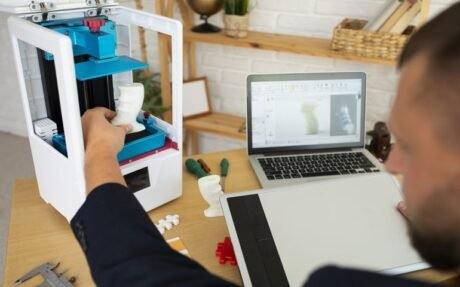Course Features
Price
Study Method
Online | Self-paced
Course Format
Reading Material - PDF, article
Duration
8 hours, 55 minutes
Qualification
No formal qualification
Certificate
At completion
Additional info
Coming soon
- Share
Overview
Who is this course for?
Requirements
Career path
-
- Introduction 00:10:00
-
- What is a Pipeline 00:10:00
- What is a Polygon 00:10:00
- Polygons in action 00:10:00
- Assignment Open Blender 00:10:00
- A small correction 00:10:00
- Your first learning tool 00:10:00
- What is a viewport 00:10:00
- What exactly is a Mesh 00:10:00
- So what is a material and how do they work 00:10:00
- What is a renderer 00:10:00
- What is a Shader 00:10:00
- Specific examples of software 00:10:00
- Assignment 00:10:00
- Basic file types 00:10:00
- Making Blender Better Looking 00:10:00
- Here’s what you have learned at this point 00:10:00
- This applies to Unreal engine 00:10:00
- Basic editing concepts 00:10:00
- What is a normal 00:10:00
- Why Bevels are Important 00:10:00
- Adjusting edges 00:10:00
- Adding geometry 00:10:00
- Different views 00:10:00
- Modeling with S.E.R.G. 00:10:00
- Mirroring 00:10:00
- Intro to Materialize 00:10:00
- What is a Diffuse Map 00:10:00
- What is a height map 00:10:00
- What is a Normal map 00:10:00
- What is Ambient Occlusion 00:10:00
- Understand metal and roughness 00:10:00
- Hand painting textures 00:10:00
- Exam of 3D Art for Beginners: Master the Basics & Bring Ideas to Life 00:50:00

No Reviews found for this course.
Is this certificate recognized?
Yes, our premium certificate and transcript are widely recognized and accepted by embassies worldwide, particularly by the UK embassy. This adds credibility to your qualification and enhances its value for professional and academic purposes.
I am a beginner. Is this course suitable for me?
Yes, this course is designed for learners of all levels, including beginners. The content is structured to provide step-by-step guidance, ensuring that even those with no prior experience can follow along and gain valuable knowledge.
I am a professional. Is this course suitable for me?
Yes, professionals will also benefit from this course. It covers advanced concepts, practical applications, and industry insights that can help enhance existing skills and knowledge. Whether you are looking to refine your expertise or expand your qualifications, this course provides valuable learning.
Does this course have an expiry date?
No, you have lifetime access to the course. Once enrolled, you can revisit the materials at any time as long as the course remains available. Additionally, we regularly update our content to ensure it stays relevant and up to date.
How do I claim my free certificate?
I trust you’re in good health. Your free certificate can be located in the Achievement section. The option to purchase a CPD certificate is available but entirely optional, and you may choose to skip it. Please be aware that it’s crucial to click the “Complete” button to ensure the certificate is generated, as this process is entirely automated.
Does this course have assessments and assignments?
Yes, the course includes both assessments and assignments. Your final marks will be determined by a combination of 20% from assignments and 80% from assessments. These evaluations are designed to test your understanding and ensure you have grasped the key concepts effectively.
Is this course accredited?
We are a recognized course provider with CPD, UKRLP, and AOHT membership. The logos of these accreditation bodies will be featured on your premium certificate and transcript, ensuring credibility and professional recognition.
Will I receive a certificate upon completion?
Yes, you will receive a free digital certificate automatically once you complete the course. If you would like a premium CPD-accredited certificate, either in digital or physical format, you can upgrade for a small fee.
Course Features
Price
Study Method
Online | Self-paced
Course Format
Reading Material - PDF, article
Duration
8 hours, 55 minutes
Qualification
No formal qualification
Certificate
At completion
Additional info
Coming soon
- Share
Offshore Structural Analysis Level 3 Advanced Diploma
Course Line237€578.64Original price was: €578.64.€17.70Current price is: €17.70.Financial Management
Course Line237€578.64Original price was: €578.64.€17.70Current price is: €17.70.Musculoskeletal Assessment Level 3 Advanced Diploma
Course Line239€578.64Original price was: €578.64.€17.70Current price is: €17.70.
Related Courses
Adobe Lightroom Classic CC: Mastering Print, Slideshow & Web Modules
€578.64Original price was: €578.64.€17.70Current price is: €17.70. 238
2383D Printing Mastery: From Beginner to Pro in 30 Days
€578.64Original price was: €578.64.€17.70Current price is: €17.70. 241
241Drawing and Illustration Level 3 Advanced Diploma
€578.64Original price was: €578.64.€17.70Current price is: €17.70. 253
253
Related Courses
Adobe Lightroom Classic CC: Mastering Print, Slideshow & Web Modules
€578.64Original price was: €578.64.€17.70Current price is: €17.70. 238
2383D Printing Mastery: From Beginner to Pro in 30 Days
€578.64Original price was: €578.64.€17.70Current price is: €17.70. 241
241Drawing and Illustration Level 3 Advanced Diploma
€578.64Original price was: €578.64.€17.70Current price is: €17.70. 253
253






